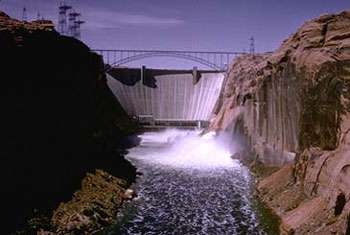Glen Canyon Dam
category : Landmarks
 On October 15, 1956, the first blast occurred and the construction of Glen Canyon Dam was officially underway. Before that date, the site was virtually inaccessible and construction crews were forced to drive 200 miles to cross from one side of the Glen Canyon to the other.
On October 15, 1956, the first blast occurred and the construction of Glen Canyon Dam was officially underway. Before that date, the site was virtually inaccessible and construction crews were forced to drive 200 miles to cross from one side of the Glen Canyon to the other.Glen Canyon Dam was engineered and constructed as part of the Colorado River Storage Project. The main purpose of the dam was to provide water storage for the thirsty southwest, and secondly, to generate power for growing communities. Colorado River reservoirs provide irrigation waters for an estimated 25% of the nation's food.
The remote location where Glen Canyon Dam stands today was selected by a group of Bureau of Reclamation engineers and geologists working from 1946 to 1948, some of whom returned to visit Lake Powell in later years. The site met several criteria: the area forming the basin would contain an immense amount of water; the canyon walls and bedrock foundation were strong and stable enough to safely support the high dam; and a large source of good rock and sand was available at nearby Wahweap Creek.
Glen Canyon Bridge was actually constructed in California, disassembled and half of the bridge was transported to each side of the canyon. By 1959, Glen Canyon Bridge was completed permitting trucks to deliver equipment and materials for the dam and the new town of Page, Arizona.
The next year concrete placement began and continued night and day until the final bucket was dumped three years later. A bucket held 24 tons of damp concrete and it took over 400,000 of them to build the dam. Over five million cubic yards of concrete make up the dam and power plant—which is equal to building a four-lane highway stretching from Phoenix, Arizona to Chicago, Illinois. Construction began on the 710-foot-tall dam with blocks of concrete 7.5 feet high.
Next, turbines and generators were installed from 1963 to 1966. In the end, 17 workers met their death during the 10 years of construction.
Glen Canyon Dam was dedicated by Ladybird Johnson on September 22, 1966. It took 17 years for Lake Powell to completely fill for the first time. At full pool—3700 feet above sea level—the lake would be 560 feet deep at the face of the dam.
The plant generates more than 1.3 million kilowatts of electricity with each of the generators 40-ton steel shafts turning at 150 rpm, generating nearly 200,000 horsepower. With all eight generators operating at full output, over 15 million gallons of water pass through the power plant's penstocks each minute. The electricity is up graded on a transformer deck from 13,800 volts to 230,000 and 345,000 volts for transmission to distant markets.
Power from Glen Canyon Dam serves a five-state grid of Wyoming, Colorado, Utah, New Mexico and Arizona. The electricity produced can provide enough energy to serve the needs of approximately 1.5 million users. The dam will be usable for an estimated 300 to 500 years and has already generated $1.5 billion in revenues.
TOURS
Visitors may tour the historic project free of charge beginning at the Carl B. Hayden Visitor Center perched above the lake and power plant. Kids will enjoy the guided tour featuring video, photography and Native American artifacts. This is an excellent family activity and one that should not be missed. Plan spending 1 to 2 hours.
The tour begins at the crest of the dam, 638 feet above the Colorado River. An elevator will take you 528 feet deep into the interior of the dam. One stop along the tour is the gallery where a digital counter registers the money collected from the sale of power.
Please note that no handbags, cameras, etc. are allowed on the tour of the actual dam. You will be asked to lock these in your vehicle or leave them behind in your hotel room.
Phone: 928-608-6404
Come visit us in Page, Arizona